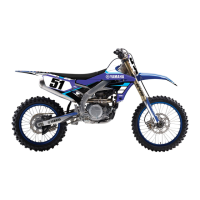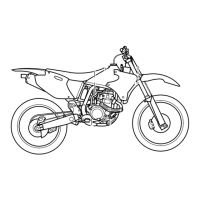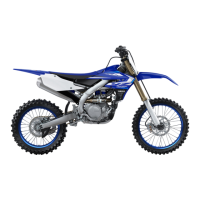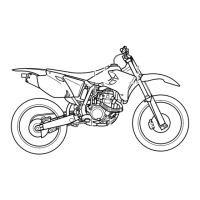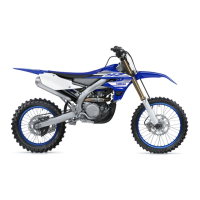Do you have a question about the Yamaha YZ426F and is the answer not in the manual?
General information and safety guidelines for operating the machine.
Critical safety precautions for operating the motorcycle.
Identification of key components and parts of the motorcycle.
Details on vehicle and engine serial numbers for identification.
Guidelines for preparation before removal and disassembly.
Recommendations for using genuine Yamaha parts and lubricants.
Inspection and handling of circlips before reassembly.
Procedure for checking electrical connectors for stains, rust, or moisture.
List of necessary special tools for tune-up and assembly.
Explanation of warning, caution, and note symbols used in the manual.
Description of the manual's sequential, step-by-step procedure format.
Guide on understanding exploded diagrams and job instruction charts.
Covers basic understanding of features, operation, maintenance, and inspection.
Provides detailed specifications for general, maintenance, and torque values.
Details maintenance intervals, pre-operation checks, and adjustments for various systems.
Covers engine-related components, removal, disassembly, and inspection procedures.
Details chassis components, including wheels, brakes, suspension, and steering.
Covers electrical components, wiring diagrams, and ignition system checks.
Provides guidance on adjusting engine and chassis settings for optimal performance.
Location and operation of the engine stop button.
Operation of the clutch lever for engaging/disengaging the clutch.
Explanation of the 5-speed transmission and gear shifting operation.
Procedure for starting the engine using the kick starter.
Operation of the decompression lever for easier starting.
Function of the throttle grip for acceleration and deceleration.
Operation of the front brake lever.
Operation of the rear brake pedal.
Operation of the fuel cock for supplying fuel to the carburetor.
Procedure for starting a cold engine using the cold starter knob.
Procedure for starting a warm engine using the hot starter knob.
Installation of the valve joint to prevent fuel outflow.
Use of the sidestand for supporting the machine when parked or transported.
Installation of accessory flap to prevent water entry into carburetor.
Step-by-step procedure for starting a cold engine.
Procedure for starting a warm engine.
Procedure for restarting the engine after a fall.
Troubleshooting steps when the engine fails to start.
Guidelines for the initial operation period to ensure optimum performance.
Procedures for frequent cleaning to maintain appearance and performance.
Preventive measures for storing the machine for 60 days or more.
Technical data including model, dimensions, engine, and chassis specifications.
Detailed specifications for engine, chassis, electrical, and tuning components.
Torque specifications for standard fasteners and units of measurement.
Schedule for regular maintenance and lubrication based on usage.
Checks to perform before riding for break-in, practice, or racing.
Inspection and maintenance procedures for engine components.
Inspection and maintenance for chassis components like wheels, brakes, and suspension.
Inspection and maintenance for electrical components and systems.
Procedures for adjusting engine and chassis settings.
Procedures for removing and installing seat, fuel tank, and side covers.
Steps for removing and installing the exhaust pipe and silencer.
Procedures for removing, inspecting, and installing the radiator.
Details on carburetor removal, disassembly, inspection, and assembly.
Procedures for camshaft removal, inspection, and installation.
Steps for removing, inspecting, and installing the cylinder head.
Procedures for valve removal, inspection, and installation.
Steps for removing, inspecting, and installing the cylinder and piston.
Procedures for clutch removal, inspection, and assembly.
Removal, inspection, and installation of oil filter, water pump, and right crankcase cover.
Removal, inspection, and installation of balancer components.
Procedures for kick axle and shift shaft removal and assembly.
Removal, inspection, and assembly of the CDI magneto.
Procedures for separating crankcase and removing crankshaft.
Removal, inspection, and assembly of transmission components.
Procedures for front and rear wheel removal, inspection, and installation.
Procedures for front brake removal, inspection, and adjustment.
Procedures for rear brake removal, inspection, and adjustment.
Procedures for front fork removal, inspection, and adjustment.
Inspection and adjustment procedures for the steering head.
Procedures for swingarm removal, inspection, and assembly.
Inspection and adjustment procedures for the rear shock absorber.
Overview of electrical components and their connections.
Explanation of the map-controlled CDI ignition system function.
Inspection steps for the ignition system and spark plug.
Inspection steps for the TPS system and its components.
Carburetor settings based on atmospheric conditions.
Adjusting front fork characteristics based on rider and circuit conditions.
Adjusting rear suspension settings for rider and circuit conditions.
General information and safety guidelines for operating the machine.
Critical safety precautions for operating the motorcycle.
Identification of key components and parts of the motorcycle.
Details on vehicle and engine serial numbers for identification.
Guidelines for preparation before removal and disassembly.
Recommendations for using genuine Yamaha parts and lubricants.
Inspection and handling of circlips before reassembly.
Procedure for checking electrical connectors for stains, rust, or moisture.
List of necessary special tools for tune-up and assembly.
Explanation of warning, caution, and note symbols used in the manual.
Description of the manual's sequential, step-by-step procedure format.
Guide on understanding exploded diagrams and job instruction charts.
Covers basic understanding of features, operation, maintenance, and inspection.
Provides detailed specifications for general, maintenance, and torque values.
Details maintenance intervals, pre-operation checks, and adjustments for various systems.
Covers engine-related components, removal, disassembly, and inspection procedures.
Details chassis components, including wheels, brakes, suspension, and steering.
Covers electrical components, wiring diagrams, and ignition system checks.
Provides guidance on adjusting engine and chassis settings for optimal performance.
Location and operation of the engine stop button.
Operation of the clutch lever for engaging/disengaging the clutch.
Explanation of the 5-speed transmission and gear shifting operation.
Procedure for starting the engine using the kick starter.
Operation of the decompression lever for easier starting.
Function of the throttle grip for acceleration and deceleration.
Operation of the front brake lever.
Operation of the rear brake pedal.
Operation of the fuel cock for supplying fuel to the carburetor.
Procedure for starting a cold engine using the cold starter knob.
Procedure for starting a warm engine using the hot starter knob.
Installation of the valve joint to prevent fuel outflow.
Use of the sidestand for supporting the machine when parked or transported.
Installation of accessory flap to prevent water entry into carburetor.
Step-by-step procedure for starting a cold engine.
Procedure for starting a warm engine.
Procedure for restarting the engine after a fall.
Troubleshooting steps when the engine fails to start.
Guidelines for the initial operation period to ensure optimum performance.
Procedures for frequent cleaning to maintain appearance and performance.
Preventive measures for storing the machine for 60 days or more.
Technical data including model, dimensions, engine, and chassis specifications.
Detailed specifications for engine, chassis, electrical, and tuning components.
Torque specifications for standard fasteners and units of measurement.
Schedule for regular maintenance and lubrication based on usage.
Checks to perform before riding for break-in, practice, or racing.
Inspection and maintenance procedures for engine components.
Inspection and maintenance for chassis components like wheels, brakes, and suspension.
Inspection and maintenance for electrical components and systems.
Procedures for adjusting engine and chassis settings.
Procedures for removing and installing seat, fuel tank, and side covers.
Steps for removing and installing the exhaust pipe and silencer.
Procedures for removing, inspecting, and installing the radiator.
Details on carburetor removal, disassembly, inspection, and assembly.
Procedures for camshaft removal, inspection, and installation.
Steps for removing, inspecting, and installing the cylinder head.
Procedures for valve removal, inspection, and installation.
Steps for removing, inspecting, and installing the cylinder and piston.
Procedures for clutch removal, inspection, and assembly.
Removal, inspection, and installation of oil filter, water pump, and right crankcase cover.
Removal, inspection, and installation of balancer components.
Procedures for kick axle and shift shaft removal and assembly.
Removal, inspection, and assembly of the CDI magneto.
Procedures for separating crankcase and removing crankshaft.
Removal, inspection, and assembly of transmission components.
Procedures for front and rear wheel removal, inspection, and installation.
Procedures for front brake removal, inspection, and adjustment.
Procedures for rear brake removal, inspection, and adjustment.
Procedures for front fork removal, inspection, and adjustment.
Inspection and adjustment procedures for the steering head.
Procedures for swingarm removal, inspection, and assembly.
Inspection and adjustment procedures for the rear shock absorber.
Overview of electrical components and their connections.
Explanation of the map-controlled CDI ignition system function.
Inspection steps for the ignition system and spark plug.
Inspection steps for the TPS system and its components.
Carburetor settings based on atmospheric conditions.
Adjusting front fork characteristics based on rider and circuit conditions.
Adjusting rear suspension settings for rider and circuit conditions.
| Displacement | 426cc |
|---|---|
| Compression Ratio | 12.5:1 |
| Ignition | CDI |
| Transmission | 5-speed |
| Final Drive | Chain |
| Front Brake | Hydraulic single disc |
| Rear Brake | Hydraulic single disc |
| Front Tire | 80/100-21 |
| Rear Tire | 110/90-19 |
| Engine Type | Liquid-cooled, DOHC, 5-valve, 4-stroke |
| Fuel System | Carburetor |
| Front Suspension | Telescopic fork, 11.8 inches travel |
| Rear Suspension | Single shock |
| Fuel Capacity | 2.1 gallons |
| Seat Height | 998 mm |

